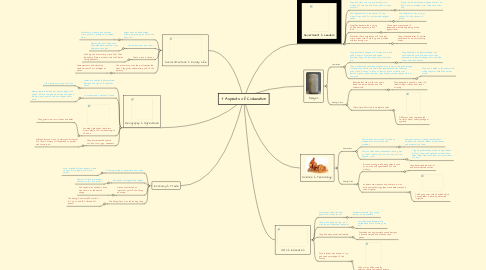
1. Social structure & Family Life
1.1. Upper class included nobles, priests, government officials and warriors.
1.1.1. Merchants, traders, and artisans were part of a middle or "freeman" class.
1.2. The lowest class was slaves.
1.2.1. Women were not free, men dominated because they were physically stronger.
1.3. There were 4 classes.
1.3.1. The king and aristocracy were first. Then the military. Next is artisans and craftsmen. Lastly, peasants.
1.4. The aristocracy was the most respected class. They governed smaller parts of the dynasty.
1.4.1. Some peasants had about the same amount of social height as slaves.
2. Economy & Trade
2.1. Economy relied on agriculture and trade
2.1.1. Jobs included pottery makers, stone cutters, brick layers, and metal smiths.
2.2. Had slaves throughout the villages
2.2.1. Woman worked as weavers, pressers, miller, and porters.
2.3. Slaves constituted an important part of the Shang economy
2.3.1. The Capital was called Yin but is also known as the xiaotun village.
2.4. The Shang/Zhou was led by king tang.
2.4.1. The Shang/Zhou lasted from 1600 B.C. up to 1046 B.C. (lasted 600 years)
3. Geography & Agriculture
3.1. Sumeria is located in Mesopotamia. Between the Tigris & Euphrates rivers.
3.1.1. The climate was very hot & dry.
3.2. Located in the "crescent" of land.
3.2.1. Mesopotamia is divided into 3 parts. Upper and Sumer. It didn't rain much in Sumer and when it did the rivers would flood,, the villages had to move.
3.3. Located right under the Yellow River Valley in the northeast region of China.
3.3.1. They grew rice, corn, wheat and millet.
3.4. They domesticated animals such as cows, pigs, sheep etc.
3.4.1. Although bronze was a common used material for tools, farmers still depended on wooden and stone tools.
4. Religion
4.1. Sumerian
4.1.1. They believed in the gods of Sumer who were gods in human form and had human qualities.They could eat, drink,marry and even die.
4.1.1.1. They believed in an immortal being who controlled the sun,earth and stars. They believed in an immortal being who controlled the sun,earth and stars.
4.1.2. They also believed that their purpose was to serve the gods through worship, prayer and sacrifice. But they believed that the major gods were too busy to listen to their prayers so there was personal gods, they would hear the prayers out and repeat them to the gods.
4.1.2.1. They had a belief in the underworld which they also called the nether world.
4.2. Shang/Zhou
4.2.1. Believed that the world was split in three, the earth, heaven, and the underworld.
4.2.1.1. They believed in spiritual control of the world by Gods and ancestor worship.
4.2.2. There were festivals to celebrate Gods.
4.2.2.1. Different Gods represented certain natural and mythological symbols.
5. Government & Leaders
5.1. They had their own city-state which was made up of the city and farm land for miles around it.
5.1.1. During the third millennium kingship arose. The king was a worshiped & sacred god to their city.
5.2. The temple stood at the center of the cities. It was used for political and religious needs.
5.2.1. The temple was also a major center for distribution of goods.
5.3. King Wen became the 1st king of the Zhou dynasty in 1099 B.C.E.
5.3.1. There were many levels of leadership with the king being at the highest level.
5.4. Warlords often ruled areas of land but were under rule of the king and provided soldiers during war.
5.4.1. They collected taxes from the people and from surrounding areas.
6. Science & Technology
6.1. Sumerians
6.1.1. The science was mostly focused on mathematics, astronomy, and medicine.
6.1.1.1. Sumerian doctors were practical about medicine and created tablets with diseases and prognosis on them.
6.1.2. Their scribes about mathematics have given us the 60 minute hour, 24-hour day, and 360 degree circle.
6.1.2.1. They kept detailed records on clay tablets. Rations, taxes, and agricultural work have been integrated from them into our modern society.
6.2. Shang/Zhou
6.2.1. Bronze casting: made many objects such as swords and spearheads for the military.
6.2.1.1. They developed the chariot and domesticated horses.
6.2.2. Used bronze weapons and chariots in war. With new technology they were able to expand their kingdom.
6.2.2.1. The Huang river valley flooded which caused them to develop advanced irrigation.
7. Arts & Education
7.1. Sculptures were the most popular of Sum,erian art.
7.1.1. Students learned by copying lessons on clay tablets.
7.2. They were made of clay, as it was the most abundant material.
7.2.1. Architecture became more skilled because of making clay art.
7.3. They had many ancestral tablets.
7.3.1. Practiced casting inscriptions and designs in bronze vessels and other bronze pieces.
7.4. Oracle bones were used to try and seek knowledge of the future.
7.4.1. The art was influenced by religious rituals and military events.
